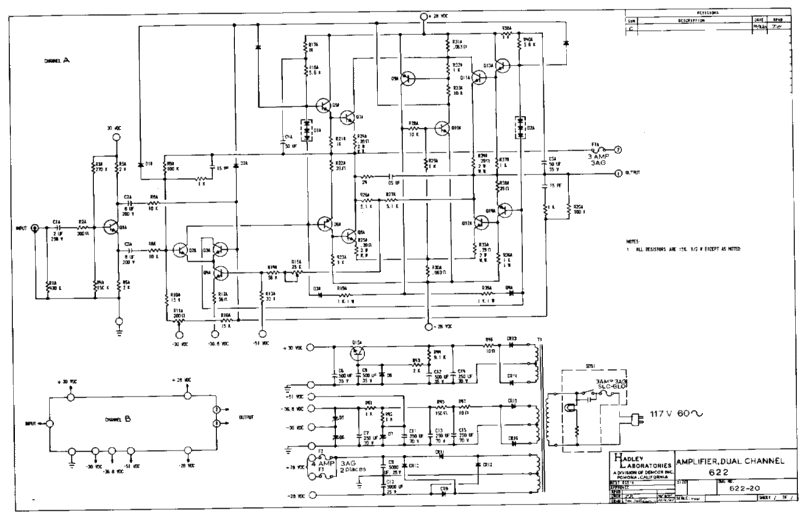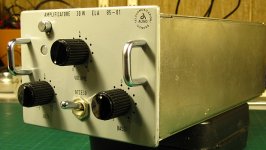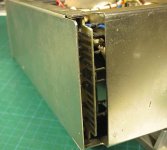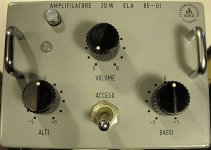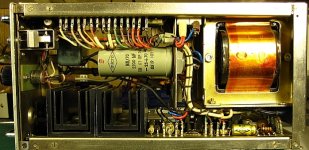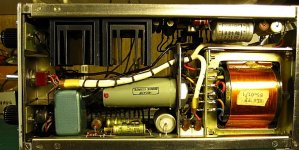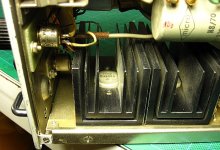I had a Bang&Olufsen receiver that used the 2N3055 and 2N2955 on a +60 V supply (AC coupled output). While working on it (fixing the Vbe multiplier), I learned the hard way that the collector is connected to the transistor case. Don't touch the case of the NPN and PNP at the same time. 
~Tom
~Tom
Very interesting amp - thank you for this advice and especially the schematic.
to find more such amp models (and not such with MJ2955/2N3055 in use by output stage) was the reason for starting this thread
about
Favorite 2 channel amplifier [Archive] - Next Level Audio & Video Forum
(last post) Hadley 622 (designed by Mr. Jim Bongiorno) is compared with Threshold Stasis 3, Bedini BA-801, and Blue Circle BC-22 MK2
here some more URLs:
PUMPED: jim Biongorno will update my Hadley 622 amp..(nudies in here) [Archive] - SH Forums
Treffen zweier alter Säcke,zwecks hören einer aussergewöhnlichen Audioanlage! - HiFi Forum
James Bongiorno Designs
http://www.diyaudio.com/forums/solid-state/10920-introducing-x-gainclone-5.html
CBA - Claus Bücher Audio
where you will find more informations
additional URLs to this circuit topology:
http://www.diyaudio.com/forums/solid-state/45272-comments-unusual-bridge-amp-3.html
* AllegroSound * Hadley 601 Stereo Tube Amp *
ampzilla2000
Unfortunately I don't find a photo with a front view of this amplifier (similar like tube based model "601"?).
Because this power silicon transistor was introduced by the Radio Corporation of America (RCA) already in the early 1960s, there must exist several of additional models from the early sixties. Such brand/models I like to know all
to find more such amp models (and not such with MJ2955/2N3055 in use by output stage) was the reason for starting this thread
about
Favorite 2 channel amplifier [Archive] - Next Level Audio & Video Forum
(last post) Hadley 622 (designed by Mr. Jim Bongiorno) is compared with Threshold Stasis 3, Bedini BA-801, and Blue Circle BC-22 MK2
here some more URLs:
PUMPED: jim Biongorno will update my Hadley 622 amp..(nudies in here) [Archive] - SH Forums
Treffen zweier alter Säcke,zwecks hören einer aussergewöhnlichen Audioanlage! - HiFi Forum
James Bongiorno Designs
http://www.diyaudio.com/forums/solid-state/10920-introducing-x-gainclone-5.html
CBA - Claus Bücher Audio
where you will find more informations
additional URLs to this circuit topology:
http://www.diyaudio.com/forums/solid-state/45272-comments-unusual-bridge-amp-3.html
* AllegroSound * Hadley 601 Stereo Tube Amp *
ampzilla2000
Unfortunately I don't find a photo with a front view of this amplifier (similar like tube based model "601"?).
Because this power silicon transistor was introduced by the Radio Corporation of America (RCA) already in the early 1960s, there must exist several of additional models from the early sixties. Such brand/models I like to know all
Attachments
-
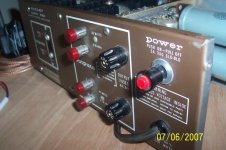 Hadley 622 rear.jpg71.3 KB · Views: 3,387
Hadley 622 rear.jpg71.3 KB · Views: 3,387 -
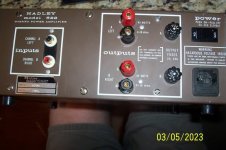 Hadley 622 rear II.jpg68 KB · Views: 3,179
Hadley 622 rear II.jpg68 KB · Views: 3,179 -
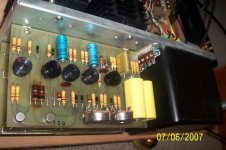 Hadley 622 inside I.jpg70.7 KB · Views: 3,219
Hadley 622 inside I.jpg70.7 KB · Views: 3,219 -
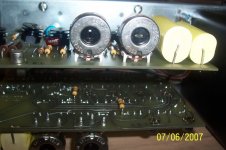 Hadley 622 inside II.jpg68.6 KB · Views: 3,145
Hadley 622 inside II.jpg68.6 KB · Views: 3,145 -
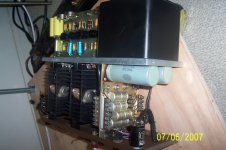 Hadley 622 inside III.jpg71.2 KB · Views: 1,032
Hadley 622 inside III.jpg71.2 KB · Views: 1,032 -
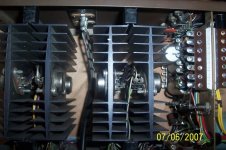 Hadley 622 inside IV.jpg87.5 KB · Views: 1,163
Hadley 622 inside IV.jpg87.5 KB · Views: 1,163 -
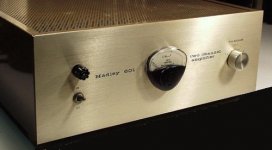 Hadley_601.jpg28.2 KB · Views: 1,180
Hadley_601.jpg28.2 KB · Views: 1,180
Last edited:
Complimentary topologies are not necessarily "better" then quasi complimentary.
At first from semiconductor physics it is impossible to have complimentary BJTs as well
als it is impossible to have complimentary n p channel MOsfets. These are truly "second order" effects but nevertheless the effects are measurable. For example in small signal
one cannot make a npn BJT with the same noise distribution as a pnp BJT. pnp BJT have
the lower low noise. This is semiconductor physics. Aside from small signal properties there are differences at large signal, too.
A complimentary symmetric push pull stage will cancel even order harmonics but these are just those which are less disturbing than odd order harmonics.
In this respect a quasi symmetric is clearly better it has in general higher thd but its odd order harmonics are always lower than even order harmonics. This, irrespective of the level of thd, sounds better.
However the disadvantage of quasi compliementary is in reactive distortion. The thd and spectrum is more sensitive to phase shifts of voltage versus current this can be seen at the dampening factors versus frequency.
At first from semiconductor physics it is impossible to have complimentary BJTs as well
als it is impossible to have complimentary n p channel MOsfets. These are truly "second order" effects but nevertheless the effects are measurable. For example in small signal
one cannot make a npn BJT with the same noise distribution as a pnp BJT. pnp BJT have
the lower low noise. This is semiconductor physics. Aside from small signal properties there are differences at large signal, too.
A complimentary symmetric push pull stage will cancel even order harmonics but these are just those which are less disturbing than odd order harmonics.
In this respect a quasi symmetric is clearly better it has in general higher thd but its odd order harmonics are always lower than even order harmonics. This, irrespective of the level of thd, sounds better.
However the disadvantage of quasi compliementary is in reactive distortion. The thd and spectrum is more sensitive to phase shifts of voltage versus current this can be seen at the dampening factors versus frequency.
The 2N3055 was made by so many manufacturers in so many chip sizes that the distinction is almost meaningless. For instance the 25watt amplifier in the Mullard audio and radio circuit book used BDY20's and it was well known at the time that you could substitute the 2N3055 for that device.
Power supply makers who were interested in getting reliable supplies used 'big chip' devices because the dissipation would meet the specifications.
Power supply makers who were interested in getting reliable supplies used 'big chip' devices because the dissipation would meet the specifications.
I agreeComplimentary topologies are not necessarily "better" then quasi complimentary.
At first from semiconductor physics it is impossible to have complimentary BJTs as well
als it is impossible to have complimentary n p channel MOsfets. These are truly "second order" effects but nevertheless the effects are measurable. For example in small signal
one cannot make a npn BJT with the same noise distribution as a pnp BJT. pnp BJT have
the lower low noise. This is semiconductor physics. Aside from small signal properties there are differences at large signal, too.
A complimentary symmetric push pull stage will cancel even order harmonics but these are just those which are less disturbing than odd order harmonics.
In this respect a quasi symmetric is clearly better it has in general higher thd but its odd order harmonics are always lower than even order harmonics. This, irrespective of the level of thd, sounds better.
[/QUOTE] However the disadvantage of quasi compliementary is in reactive distortion. The thd and spectrum is more sensitive to phase shifts of voltage versus current this can be seen at the dampening factors versus frequency.[/QUOTE]
Please note, there are different versions of quasi complementary versions. By certainly versions you are right. Also the clipping behavior is by certainly versions rather unfavorable compare to the true complementary versions.
Look to my overview of a wide range from different versions where are only NPN BjTs resp. N-CH MOSFETs in the output stage.
go to
http://www.diyaudio.com/forums/soli...better-audio-non-complements-audio-power.html
http://www.diyaudio.com/forums/solid-state/154388-its-cheap-its-n-its-dirty-its-circlomos.html
Quad 303 (not 405, the current dumping verion !)
I have found a famous amp circuit topology again: The Quad 303 -
about post #6 and #7 from
http://www.diyaudio.com/forums/solid-state/162310-how-identify-quasi-complementary-amplifier.html
and
http://www.diyaudio.com/forums/solid-state/113943-quad-303-triple-cascade.html
you will find more informations
I have found a famous amp circuit topology again: The Quad 303 -
about post #6 and #7 from
http://www.diyaudio.com/forums/solid-state/162310-how-identify-quasi-complementary-amplifier.html
and
http://www.diyaudio.com/forums/solid-state/113943-quad-303-triple-cascade.html
you will find more informations
perhaps the "P 10" ?and receiver. Used transformer coupling to 3055 outputs as I remmeber.
CHarles
Acoustic Research P-10 | Owners Manual, Service Manual, Schematics, Free Download | HiFi Engine
Acoustic Research P10, P-10 Power Amplifier. - eBay (item 230438951720 end time Mar-19-10 13:24:51 PDT)
Maybe the Power Amplifier "XEC-1000" (XEC1000B) from Dayton Wright could also use 2N3055 quasi complementary output stage - who know this exactly?
on the web I found only a low resolution pic by the photo from it's owner's manual
about
ebay Item number: 160052997987
http://cgi.ebay.com.my/1976-Dayton-...ptZVintage_Electronics_R2?hash=item2543e6ef63
for this amp I have started a new thread:
http://www.diyaudio.com/forums/soli...ower-amplifier-xec-1000-schematic-wanted.html
on the web I found only a low resolution pic by the photo from it's owner's manual
about
ebay Item number: 160052997987
http://cgi.ebay.com.my/1976-Dayton-...ptZVintage_Electronics_R2?hash=item2543e6ef63
for this amp I have started a new thread:
http://www.diyaudio.com/forums/soli...ower-amplifier-xec-1000-schematic-wanted.html
Attachments
Last edited:
It comes in my mind that the B&O Beomaster 3002 receiver, of 70s, had power stages made by Motorola's 2x2N3055 per channel @ 2x40Wrms/4 ohms.
Thank you. here an auction from ebay:
Bang & Olufsen B&O Beomaster 3000-2 Top ! bei eBay.de: Receiver (endet 15.02.10 19:39:02 MEZ)
Verly large amount of photos
If don't goes open, try item No 220552777414 from the ebay start site
March 05
@ tiefbassuebertr: Yes very nice.
But what we have here: is a rather unknown and non famous power amp used for audio monitoring in the broadcasting studios of 70s. It's a mono-block heavy duty 30W (2x2N3055) power amp with balanced and floating transformer input of a modular plug-in design. See the pics.
@ tiefbassuebertr: Yes very nice.
But what we have here: is a rather unknown and non famous power amp used for audio monitoring in the broadcasting studios of 70s. It's a mono-block heavy duty 30W (2x2N3055) power amp with balanced and floating transformer input of a modular plug-in design. See the pics.
Attachments
Last edited:
@ tiefbassuebertr: Yes very nice.
But what we have here: is a rather unknown and non famous power amp used for audio monitoring in the broadcasting studios of 70s. It's a mono-block heavy duty 30W (2x2N3055) power amp with balanced and floating transformer input of a modular plug-in design. See the pics.
This was a good advice (and the amplifier keywords "broadcast" "monitoring" "ELA" and "Cinema" but not "audio" and "Hifi").
In the attachement a cinema amplifier series from Philips, that could have also 2N3055 inside, even for the neg. half (but I don't know exactly).
I quess, in the first time of 2N3055 release from RCA (1962 or so) and the end of 1960th this power transistor was only inside in professional amplifier devices, because it's too high costs for the comsumer marked (in opposite to germanium power devices).
In comsumer products from this aera I find often the germanium power transistor AD149, not only from Siemens and TFK, but sometimes also from RCA: AD149 PNP Germanium Transistor - Welcome to Valley Electronics E-Store
so as the complementary germanium pair AD161/162
In Germany even in the early 1970th (Braun, ITT SchaubLorenz and Blaupunkt car radios) this germanium versions still in use in the consumer audio components.
Attachments
-
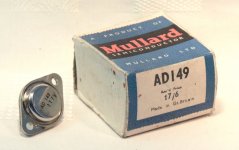 AD149 Mullard + package.JPG63.7 KB · Views: 726
AD149 Mullard + package.JPG63.7 KB · Views: 726 -
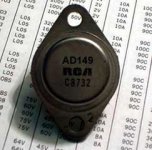 AD149 RCA .jpg10.8 KB · Views: 471
AD149 RCA .jpg10.8 KB · Views: 471 -
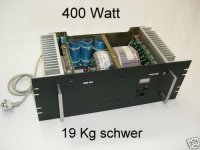 Philips SQ40 ebay.jpg24.4 KB · Views: 839
Philips SQ40 ebay.jpg24.4 KB · Views: 839 -
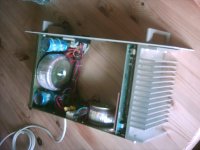 Philips SQ-40 inside.jpg646.3 KB · Views: 657
Philips SQ-40 inside.jpg646.3 KB · Views: 657 -
Philips SQ-40 front+inside black.pdf121 KB · Views: 361
-
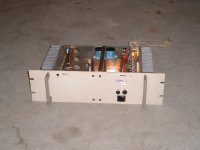 Philips SQ40 silber.jpg52 KB · Views: 722
Philips SQ40 silber.jpg52 KB · Views: 722 -
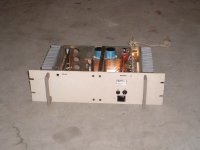 Philips SQ-40.jpg45.7 KB · Views: 577
Philips SQ-40.jpg45.7 KB · Views: 577 -
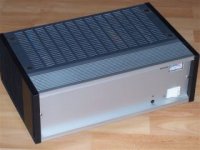 philips LBB-1003.jpg15 KB · Views: 448
philips LBB-1003.jpg15 KB · Views: 448 -
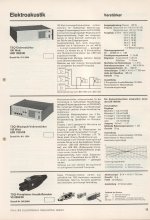 Philips LBB-1003 shortform.jpg340.9 KB · Views: 550
Philips LBB-1003 shortform.jpg340.9 KB · Views: 550
Who can post the first commercial advertisement (announcement) from formerly's brand RCA (from any electronic magazine published in the early sixties) concerning the 2N3055 and the first RCA application notes?
At which time was exactly launched the production?
I note, that the German brand Siemens launched the same type under the type number "BD130" in the seventies - unfortunately I don't find original datasheet online:
http://www.alldatasheet.com/datasheet-pdf/pdf/317819/COMSET/BD130.html
At which time was exactly launched the production?
I note, that the German brand Siemens launched the same type under the type number "BD130" in the seventies - unfortunately I don't find original datasheet online:
http://www.alldatasheet.com/datasheet-pdf/pdf/317819/COMSET/BD130.html
Last edited:
Who can post the first commercial advertisement (announcement) from formerly's brand RCA (from any electronic magazine published in the early sixties) concerning the 2N3055 and the first RCA application notes?
At which time was exactly launched the production?
I note, that the German brand Siemens launched the same type under the type number "BD130" in the seventies - unfortunately I don't find original datasheet online:
BD130 datasheet pdf datenblatt - Comset Semiconductor - NPN SILICON TRANSISTOR POWER LINERAR AND SWITCHING APPLICATIONS ::: ALLDATASHEET :::
Maplin did a 225WRMS kit using these transistors.
I built mine around 1980.
Currently offers there unfortunately only this:Maplin did a 225WRMS kit using these transistors.
I built mine around 1980.
Audio Modules : Maplin Electronics
but BK could have such modules
http://www.bkelec.com/Modules/Amplifiers.htm
Last edited:
Currently offers there unfortunately only this:
Audio Modules : Maplin Electronics
but BK could have such modules
Modules
Maplin are a bit poor now on amplifier kits.
I ran a disco and built a couple of their amplifiers.
They did a good sound to light unit as well.
They also supplied an enclosure for dual record decks for a disco.
- Home
- Amplifiers
- Solid State
- 2N3055 inside - commercial famous amplifier models, quasi complementary power output
